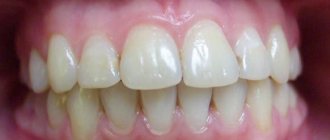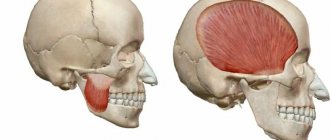Fangs, or dantes kanini, are teeth that are cone-shaped and located in two on the upper and lower jaws. The canines of the upper jaw are always larger than the lower ones. They occupy the third place from the midline and have a spear-shaped crown. They serve to hold food and then tear it apart. The lingual surface has a concave appearance and tubercle, while the labial surface, on the contrary, is more convex. In fangs, the roots have a slightly laterally compressed shape, but at the same time they are the longest and strongest.
Fernand Joseph Contandin - owner of the largest teeth in the world
At the moment, the actor, who went down in cinematic history under the nickname Fernandel, is considered the man with the largest and longest teeth in the world.
It cannot be said that it was his teeth that helped Fernandel become famous. However, the actor became famous throughout the world, received the Legion of Honor award and was named one of the most outstanding citizens of France, earning great respect from the public. It is believed that Fernandel can be recognized by his teeth. Just like Charlie Chaplin, by the mustache. The audience especially enjoyed those moments when the actor whistled loudly.
What symptoms indicate that fangs are cutting?
Signs of the impending appearance of fangs appear in babies long before the moment when these teeth appear from the gums. Usually, symptoms of their appearance are encountered 2-4 weeks before tooth eruption , but there are often situations when the fangs begin to bother the baby even earlier.
In a child with teething teeth, parents will notice:
- Bad mood, irritability and moodiness.
- Excessive production of saliva , which can cause a cough or runny nose.
- Swollen and discolored gums in areas where the fang is expected. They turn red and become more prominent, after which a new tooth appears under the gum in the form of a white dot.
- Decreased appetite, and sometimes refusal to eat.
- Restless sleep , disturbed by soreness and burning in the gums.
- The desire to gnaw and chew on various objects so that they scratch the gums.
Read also: When do babies have their first teeth?
A pediatrician of the highest category, Mikhailova T.M., tells more about the symptoms.
Such symptoms are observed in many babies, but when fangs erupt, they are often accompanied by more unpleasant signs, including:
- Temperature rises to +37.5+38°C (less often up to +39°C) within 1-3 days.
- Loose stool , caused by excess saliva swallowed by the baby.
- Strengthening the gag reflex , which is also associated with a large amount of saliva in the toddler’s mouth.
- Rash on the chin due to the irritating effects of saliva.
Interesting facts about human teeth
It is not difficult to guess that Hollywood stars use expensive dental services to ensure the best dental condition and give the public an excellent smile. However, we must never forget that our teeth are a valuable gift of nature, and they have their own characteristics.
It is now known that tooth enamel is the strongest tissue in the human body. High hardness of tooth enamel is necessary in order to cope with a wide variety of foods. All people have unique sets of teeth. It doesn't matter how big or small they are. This is due not only to genetics, but also to lifestyle features. A large volume of saliva accumulates in the oral cavity every day. Up to one and a half liters per day. This is necessary to protect teeth from bacteria, additional cleaning of enamel, etc.
How human teeth evolved
There is not a single person in the modern world who could surpass the size of teeth of those people who lived approximately 100 thousand years ago. Our ancestors had very large and long teeth, because they needed to eat rough plant foods and raw meat. The digestive system was also different, but it adapted to the corresponding reality. Anthropologists have calculated that human teeth have been steadily shrinking since then—by about 0.95% in each era.
While studying the remains of the skulls of ancient people, scientists noticed that they had large and long fangs that allowed them to hold food. Currently, the largest and longest tooth is the first molar, located on the upper jaw.
Can large and long teeth be considered a pathology?
Long teeth cannot be called a pathology if they grow normally. There are many examples in the world of people who have large teeth, but they have no problems in everyday life. The most striking examples are the inhabitants of island states. Some of them have very powerful jaws, with which they can easily cut through plant food and even peel the fruits of exotic trees.
The problem with large and long teeth begins the moment twisting occurs. Due to the developing malocclusion, a person begins to experience discomfort, and his smile loses its aesthetics. The bite is important for the digestive system, so it should be taken care of. All over the world, doctors recommend monitoring the condition of your teeth, not only by using toothpaste, but also by performing a dental examination in front of a mirror. Because of large teeth, people often experience communication problems.
When children's fangs erupt: timing, symptoms and first aid
The eruption of fangs in children is accompanied by symptoms that will make everyone in the household worry. The child refuses to eat and is capricious due to severe jaw pain that radiates to the eyes and ears. Excessive anxiety of the baby frightens parents, making them wonder whether the process is going normally, how to alleviate the baby’s condition during this period, and whether a doctor is needed. These and other points are discussed in the article.
How to distinguish big teeth
There are certain standards for the teeth of Europeans. It is determined in the world that the norm for the length of the upper incisors should be a maximum of 13 mm, for the lateral ones it is approximately 2 mm shorter. If the norm is exceeded by one and a half times, then it is customary to diagnose macrodentia.
Long teeth can be corrected. The most common method is grinding. Sometimes it cannot be resorted to, so correction followed by restoration is used. If the reason your teeth appear large is due to an incorrect bite, braces are used. The fashion world's beauty standards are often surprising, so it's normal for people with big, long teeth to gain a lot of publicity. Some of the most famous Hollywood stars, such as Julia Roberts and Anne Hathaway, have very interesting smiles. Therefore, deviation from the norm cannot always be considered something bad. If the teeth do not interfere, then they can be left as nature intended them. There are a number of famous actors who consider their large and long teeth to be a gift.
- Brigitte Bardot is one of them. She was considered a real ugly duckling, because she not only had an incorrect bite, but also the most unattractive appearance in the class. The girl's lower lip was protruding and she had a squint. Gradually, the strabismus was overcome, and Brigitte decided to leave the malocclusion. This made her incredibly popular all over the world.
- Amy Winehouse was also a singer who was not at all bothered by large teeth. Emmy's front incisors seem huge, so her smile was perceived ambiguously by the public. But the British performer loved to smile widely. Amy Winehouse loved to test her strength by smoking cigarettes and drinking alcohol. And yet, at one fine moment, the girl thought about the health of her oral cavity and put her teeth in order.
- Keira Knightley is considered one of the most popular film actresses around the world. The actress has large incisors, and she has never tried to change her smile. On the contrary, Knightley became a fan of her own bite and showed it to the whole world without being at all embarrassed. In Hollywood, the actress is considered one of the best, so no one pays attention to Knightley’s large incisors or bite.
- Benedict Cumberbatch is another actor whom nature decided not to bestow with a beautiful smile. But he is considered one of the most popular actors in the world of the last decade. Having starred in the TV series Sherlock, he was able to win a huge audience thanks to his charisma. His smile is often compared to a crooked picket fence, his long incisors seem scary, but this does not stop Benedict from starring in films and TV series. He is a truly charismatic person, so he easily wins people over.
- Katy Perry has a very interesting take on her own smile. The world knows her as one of the most popular singers, but Katy Perry herself is not very happy with the way her teeth look. Having gained great popularity, the girl still believes that she was unlucky with her smile. However, she does not want to change what nature has given her. Katy Perry is known for her original look at her appearance, so she is not afraid to change her hair color, dyeing her hair green and even purple.
Indications for GZ extraction
Removal of permanent fangs is carried out in the following cases:
- in the presence of a pathology in the growth of dental units, which may subsequently affect the bite;
- the tooth is incorrectly positioned in the row, interfering with the eruption of “neighbors”;
- the erupting unit is irregular in shape or large in size.
It is important to understand that after extraction the chewing load will be redistributed differently, and this may subsequently affect the health of the remaining teeth. That is why dentists rarely recommend removing such units without good reason. An alternative is to grind down the uneven part of the tooth and install braces.
So, in dental practice, dental teeth are usually called the canines of the upper and lower jaws. Due to their anatomical features, such teeth erupt extremely painfully and cause both children and adults a lot of inconvenience.
To facilitate the process of “birth” of these units of the dentition, patients are prescribed symptomatic treatment (local and systemic painkillers, antipyretic drugs). You can buy special devices for babies in pharmacies - teethers. Permanent gastrointestinal tracts are removed extremely rarely if there are serious indications.
What to eat to strengthen your teeth
Taking care of your oral cavity requires more than just a toothbrush. Nutrition plays an important role. It is no coincidence that doctors recommend giving up sugar, since bacteria that live in the mouth convert substances into acid, which negatively affects tooth enamel.
Unfortunately, many products contain sugar or sweeteners, so you won’t be able to avoid trouble. The best products for teeth are:
- cheese;
- chicken;
- meat;
- nuts;
- milk.
It is thanks to them that the enamel can be protected, as they contain important substances, including calcium and phosphorus. Calcium is practically the most important element. It is found in large quantities in fish, beets, legumes, nuts (almonds), and grapes. In Arab countries, they prefer to consume honey, and this is good for the teeth, since such a delicacy contains a lot of calcium. You can also resort to using medications. There are even some that contain calcium in combination with vitamin D.
The vitamin promotes better absorption of the substance, although it can be obtained from foods such as liver. A large amount of vitamin D contains fish oil, which is sold in any pharmacy.
Fluoride is no less important. It is he who is responsible for protecting the enamel. Thanks to fluoride, acid-resistant compounds are formed that prevent the formation of caries. It is best to buy fluoridated water, as this is the easiest way to provide the body with enough of this substance. Dairy products containing fluoride are sold on supermarket shelves. You can also buy fluoridated salt.
Diet is important for a person. It is better to choose products whose dietary fiber is quite coarse. Various dried fruits may be a good option to replace the usual sweets, but due to their high sugar content they negatively affect tooth enamel. Sweet carbonated drinks are harmful, the same goes for tea with sugar or coffee. To minimize the harmful effects of sugar, you can chew gum and brush your teeth 3 times a day.
What diet should you choose for your teeth?
It is necessary to monitor your carbohydrate intake. If you really want something sweet, it is better to choose honey, since it does not form a persistent film on the surface. Modern sweeteners are substances that are quite aggressive towards tooth enamel. Natural honey has minimal impact on the enamel.
You should include plant fiber in your food, as it helps to better clean your teeth and strengthen your gums, so you should minimize the consumption of freshly squeezed juices or grated fruits (vegetables). Coarse fiber is needed for teeth.
Acidic foods help improve salivation. It can be fruits, cabbage, broths, vegetables. You should not exclude seaweed from your diet. Saliva has anti-caries properties, washing away bacteria; moreover, it contains lysozyme, which strengthens tooth enamel.
So what to do? It may seem that it is necessary to give up many of the pleasures of life. Sweets are an antidepressant and promote the production of endorphins. Of course, you don’t need to deny yourself the consumption of sweets, but try to keep it in moderation and choose ones that contain a minimum of sugar. You can simply brush your teeth regularly for at least 3 minutes and use chewing gum after meals, chewing it thoroughly for about 10 minutes.
What symptoms appear when a child has fangs?
The most striking symptom of teething in a child is excessive salivation, but such a manifestation does not occur immediately. 3-4 weeks before the moment when the tooth should erupt from the gums, preparation of its roots begins. The process is invisible externally, but the baby already feels discomfort, so the initial signs of early teething are manifested by changes in behavior:
- there is no mood, causeless whims appear;
- sleep becomes restless, its rhythms are disturbed;
- there is a need to put things in the mouth and chew on toys.
External symptoms of canine teething will appear when a small white spot forms on the lower gum - this is a baby tooth ready to erupt to the surface.
External signs
2-3 days after the baby’s mood deteriorates, parents may notice the first visible signs of teething:
- in places where teeth grow, swelling and redness are observed, the gums become prominent, as in the photo;
- pain increases in the area of the gum where the new tooth will emerge;
- salivation increases;
- the temperature rises to low-grade levels – 37–37.3 °C;
- The child’s appetite noticeably worsens, sometimes he completely refuses food.
The most difficult time for parents is when the child’s fangs erupt with an increase in unpleasant and painful symptoms:
- drooling causes irritation around the mouth and a rash on the chin;
- loose stools are possible, which, according to pediatricians, is the result of swallowing a large volume of saliva;
- salivation can provoke vomiting;
- when the fangs climb to the surface, the child’s body temperature can reach critical values – up to 38–38.5 °C;
- Increasing itching covers nearby tissues.
A child who is teething constantly chews on toys in order to somehow suppress the itching and painful sensations in the gums.
Temperature
If body temperature does not exceed normal limits, such hyperthermia is considered a normal physiological manifestation of the body’s internal defenses. When a child loses his lower or upper fangs, his gums become inflamed, so the body mobilizes internal reserves to fight inflammation, which is accompanied by an increase in temperature.
What parents should consider:
- How many degrees can the thermometer increase? According to pediatricians, values exceeding 39 °C are critical for a child.
- How long can the temperature last? It is unacceptable for a high temperature to last longer than 3-4 days. A slightly elevated temperature usually subsides after 5–7 days.
If hyperthermia continues for a long time, or the thermometer rises too high, you need to seek medical help. The child’s body, weakened due to teething, is susceptible to viruses and infections, so the baby could become seriously ill.











